
albert Chan
What’s the Story?
Coresight Research has identified inclusivity—providing equal access for people who might otherwise be excluded or marginalized—as one of the key trends to watch in retail. Inclusivity has accelerated in light of the racial justice movement in the US helping to inspire a global conversation on diversity and representation.
In this report, we explore inclusivity on social media, covering the opportunities presented by population diversity in the US and the strategies that brands and retailers are implementing to incorporate and promote inclusivity online.
Why It Matters
Inclusivity is a thread that touches every part of an organization, both internally and externally, as shown in Figure 1. Companies are focusing on their corporate strategies to improve diversity across their organization. However, they must ensure that their commitments to diversity and inclusivity are communicated effectively to consumers, who are increasingly demanding transparency and authenticity in these areas. One way to do this is through social media marketing: A brand’s digital presence impacts consumer perceptions of the brand’s values. The images and voices used on social media should reflect a company’s culture, values and products.
In addition, it is important for social media campaigns to better represent the population in terms of race, gender and disabilities. The US is diverse and hyper-connected, so there is potential for brands and retailers to serve and engage with a broader consumer base.
A major benefit for brands and retailers of diverse representation and inclusivity initiatives relates to consumer purchase behavior. In May 2021, a Nielsen Computer & Mobile Panel and Attitudes on Representation on TV Survey found that over 35% of US consumers across all age groups would be “more likely” or “much more likely” to buy products from brands whose advertising content featured individuals from their own identity group. Furthermore, according to a study in 2019 by social media company Facebook and the Geena Davis Institute on Gender in Media, 59% of consumers reported that they prefer to purchase from brands that stand for diversity and inclusion in online advertising.
Figure 1. Inclusivity Spans Operations, Products and Marketing [caption id="attachment_135694" align="aligncenter" width="700"]
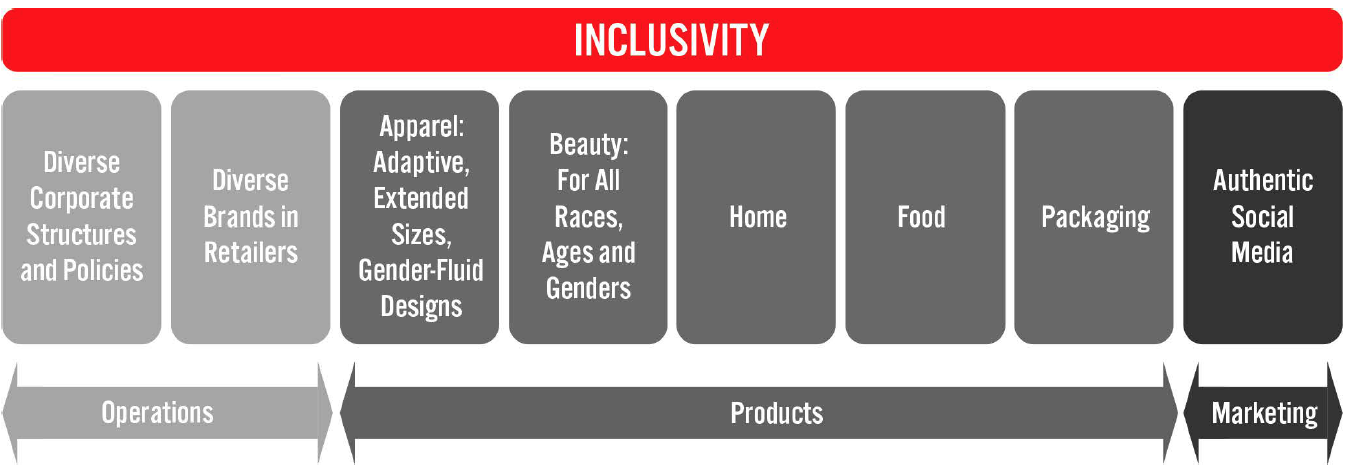 Source: Coresight Research[/caption]
Source: Coresight Research[/caption]
Inclusivity on Social Media: Coresight Research Analysis
Social Media Is a Driving Force, Not Just a Marketing Tool
The social unrest of 2020 propelled the inclusivity conversation into the spotlight, and calls for change were driven by consumers through social media.
In June 2020, there was an outpouring on social media related to the Black Lives Matter movement. The “Pull Up or Shut Up” challenge was created to demand that big beauty companies reveal their corporate diversity metrics, as it was believed that they were promoting messages on social media that did not match their internal organizational structures.
[caption id="attachment_135695" align="aligncenter" width="300"]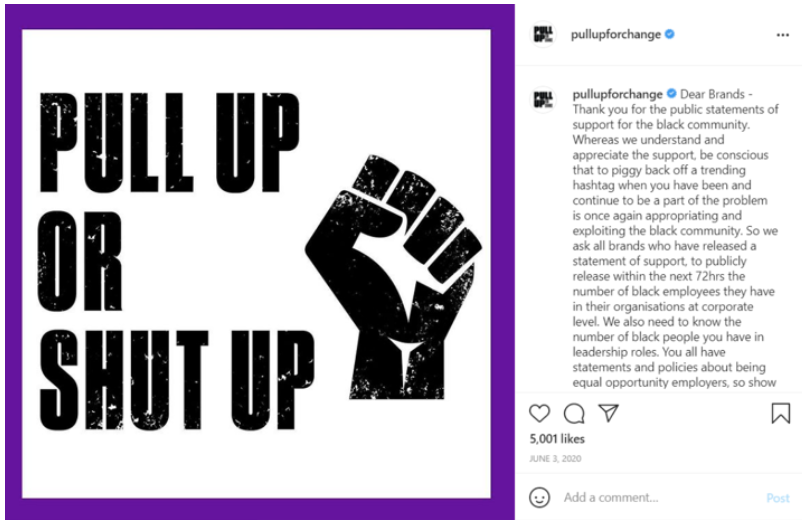 The “Pull Up or Shut Up” challenge on social media, June 3, 2020
The “Pull Up or Shut Up” challenge on social media, June 3, 2020Source: Instagram[/caption]
Further highlighting the power of social media in driving organizational change, there was a call to action on social platform Instagram in the summer of 2020 for retailers to pledge 15% of shelf space to Black-owned brands. Companies that sign up to the “15 Percent Pledge,” created by Aurora James, Creative Director and Founder of luxury accessories brand Brother Vellies, are asked to conduct an internal audit of their current spending power and contracts allocated to Black businesses, along with committing shelf space.
Consumer demand communicated through social media has provided the impetus for companies to implement more inclusive teams and hiring policies, use more diverse suppliers and product owners, offer more inclusive products to represent a wider consumer base, and create an integrated social marketing and media strategy to reflect inclusive values. Inclusivity on social media should therefore be looked at as an integral part of a brand’s or retailer’s overall corporate strategy rather than an afterthought.
The Increasingly Diverse US Population Presents Opportunity
As brands and retailers seek to better represent consumers on social media, they should look at six key areas of diversity in the US population, which we highlight in Figure 2 and discuss in further detail below.
Figure 2. US Population: Diversity Highlights [caption id="attachment_135696" align="aligncenter" width="700"]
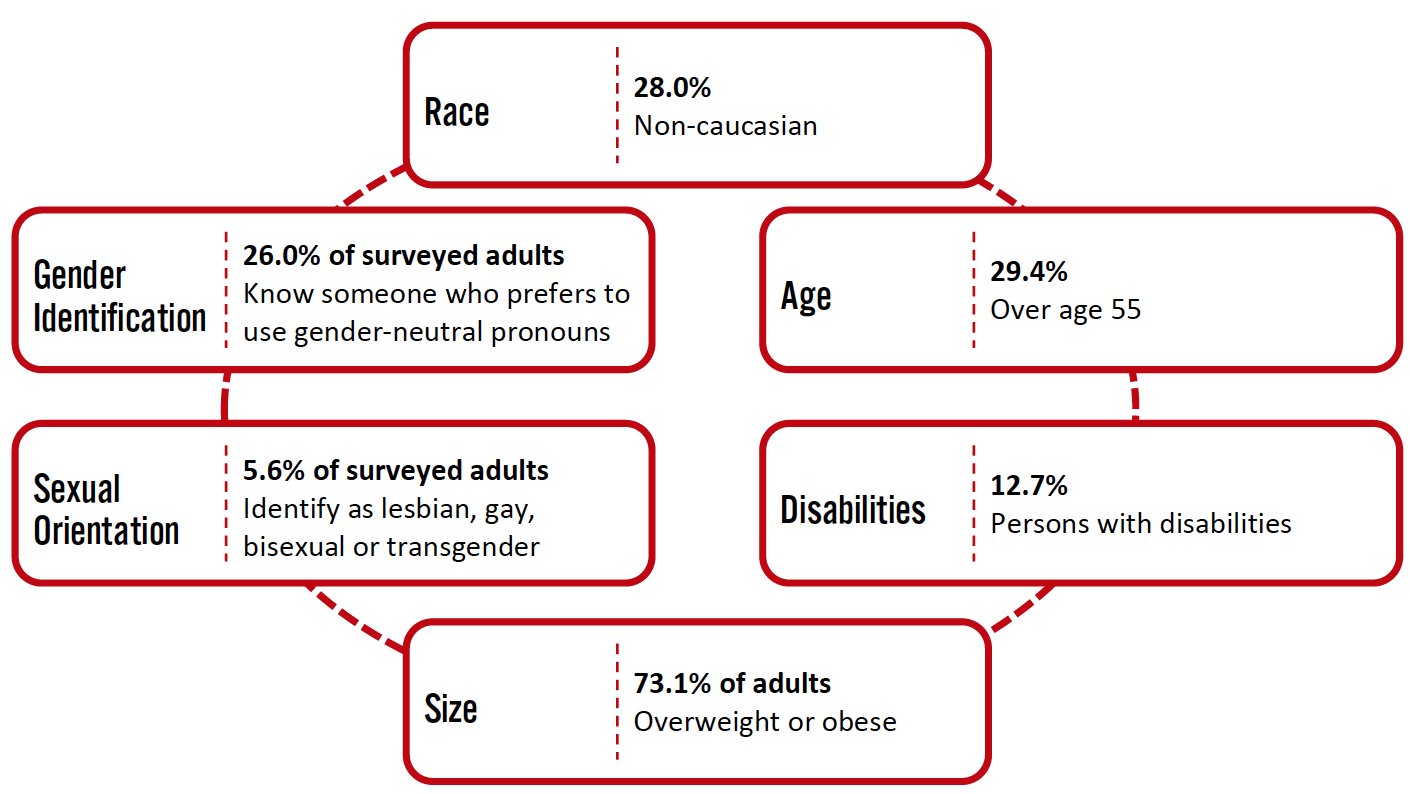 Source: Centers for Disease Control and Prevention/Pew Research Center/US Census Bureau[/caption]
Source: Centers for Disease Control and Prevention/Pew Research Center/US Census Bureau[/caption]
Race
The US population has become more racially diverse over the past 10 years: According to the US Census Bureau, 72.0% of the population identified as white in 2019—down from 74.2% in 2010. Brands and retailers should use social media to connect with a broader consumer base.
Age
Consumers aged over 55 are an often-forgotten category on social media, despite being the fastest growing and one of the largest demographic groups. In 2019, the over-55 age group comprised 29.4% of the population, up from 24.9% in 2010, according to the US Census Bureau. There is an opportunity to represent this consumer group on social media, as 88% of female baby boomers reported that that they are underrepresented in ads, and 81% reported that they prefer to buy from brands that feature a mixture of ages in their ads, according to a 2021 AARP Survey of Women’s Reflections on Beauty, Age and Media.
Disabilities
US Census Bureau data show that 12.7% of the population reported having a disability in 2019. Persons with disabilities are severely under-represented on social media: The study by Facebook and the Geena Davis Institute on Gender in Media in 2019 found that persons with disabilities were represented in 1.1% of Facebook video ads. There is therefore significant opportunity for brands and retailers to improve their representation of persons with disabilities on social media.
Size
The proportion of US adults that are overweight has been increasing in recent years, according to the Centers for Disease Control and Prevention. Approximately 30.7% of adults are overweight (body mass index of 25.0–29.9 kg/m2) and 42.4% of adults are obese (body mass index of 40.0 kg/m2 or above), according to the organization’s latest estimates in 2018. Size inclusivity is therefore key for brands and retailers to incorporate into advertising campaigns—to represent a diverse consumer base and appeal to shoppers across retail more broadly as well as to effectively promote product offerings in the plus-size apparel market.
Sexual Orientation and Gender Identification
According to a Gallup Poll survey, 5.6% of the US population identified as lesbian, gay, bisexual or transgender in 2020, up from 4.5% in the Gallup Poll’s previous estimate in 2017. However, the study by Facebook and the Geena Davis Institute on Gender in Media in 2019 found that members of the LGBTQ+ community were present in only 0.3% of Facebook video ads.
According to a Pew Research Center survey conducted in June 2021, 26% of US adults know someone who prefers to use gender-neutral pronouns.
Brands and retailers should be mindful of inclusivity on social media with regards to sexual orientation and gender identification.
Strategies To Promote Inclusivity via Social Media
Brand Ambassadors
A brand ambassador is an individual who is hired to act as the face of the brand and increase brand awareness; they are typically a well-known celebrity. Ambassadors can represent the brand through the brand’s platforms as well as through their own social media accounts, helping to drive sales among their established follower/fan base. Retailers can use a variety of brand ambassadors to promote their product portfolios and appeal to specific groups of target consumers.
- Beauty company L’Oréal has a long history of using brand ambassadors from diverse backgrounds, including icons from the film, fashion and music industries. The company reported that these “international spokespeople reflect the diversity of our customers—whatever their age, whatever their origin.” The company has used brand ambassadors since the launch of its “Because We’re Worth It” in 1971, which focuses on empowerment; L’Oréal has worked with more than 90 brand ambassadors since then. Recent L’Oréal brand ambassadors include diverse female celebrities aged over 45, such as 76-year-old Helen Mirren, Black actress Viola Davis, Canadian singer Celine Dion, American actress Eva Longoria, Indian actress Aishwarya Rai and Chinese-born Singaporean actress Gong Li.
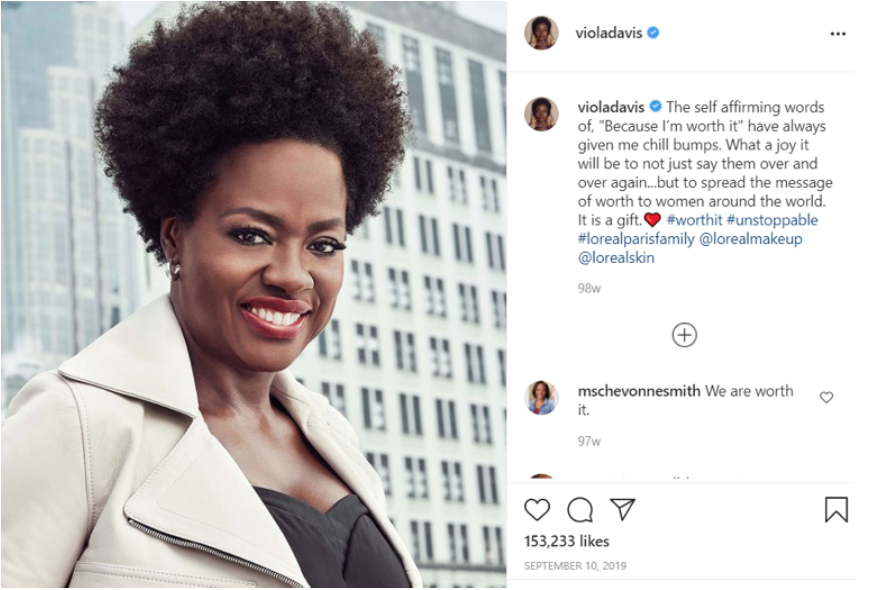 Academy-award winning actress Viola Davis is a L’Oréal Brand Ambassador
Academy-award winning actress Viola Davis is a L’Oréal Brand AmbassadorSource: Instagram[/caption]
Influencers
Brands and retailers can use social media influencers to connect with consumers, particularly young audiences through livestreaming (live video content) on platforms such as Instagram, TikTok and YouTube. Influencers share their opinions of products with fans and followers, as well as sharing product experimentation such as makeup application and outfit combinations. Effective social media influencers truly reflect the brand’s overall story and image.
- American Eagle Outfitters collaborated with Remi Bader, fashion influencer and curve model, on a social media campaign for its Aerie brand. The #AerieREAL Positivity Challenge was launched in January 2020 as part of the company's six-year initiative to promote real women's bodies. It encouraged users to upload untouched photos of themselves to Instagram or TikTok. American Eagle Outfitters committed to donating $1 to the National Eating Disorders Association for every photo uploaded with the #AerieREAL hashtag. Bader’s TikTok account has 1.8 million followers, and she gained popularity through her honesty and authenticity. Her content focuses on body positivity and being comfortable with oneself; she tries on extended-size products from various brands and retailers and reviews the items.
 Remi Bader, a social media influencer, reviews plus-size clothing
Remi Bader, a social media influencer, reviews plus-size clothingSource: Remi Bader/TikTok[/caption]
- Milk Makeup is a makeup brand that has been a pioneer in gender-free beauty: Its 2017 video campaign featured seven models representing diversity in gender and sexual orientation. The company continues to promote diversity in beauty throughout its social media channels, using influencers that demonstrate how they are using products while highlighting their personal stories and inspiration. For example, as shown in the images below, influencer Noah the Creative shared a video on Instagram of him trying on Milk Makeup products and talking about how he is a Black, trans man and is “inspired by all of the Black, queer, trans people who are very vocal about their lives and their experiences because it motivates [him] to inspire others to be authentic and vulnerable and to just live in their truth.”
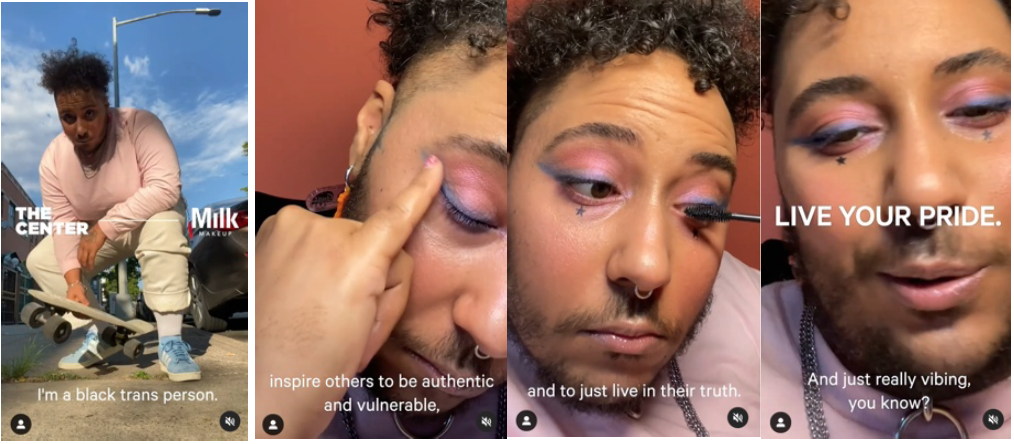 Noah the Creator, an influencer, posts content about Milk Makeup on Instagram on June 22, 2021
Noah the Creator, an influencer, posts content about Milk Makeup on Instagram on June 22, 2021Source: Instagram/Milk Makeup[/caption]
Community Building
In addition to using influencers to communicate authenticity and tap existing follower bases, brands and retailers can also collaborate with influencers to build communities and gain valuable feedback about their brand and products, which is key in understanding consumer wants and needs.
- In January 2021, sportswear brand Athleta announced the expansion of its extended-size collection (1X–3X or sizes 18–26) to 350 styles, with plans to offer extended sizing across 70% of its portfolio by spring 2022 and 100% by the end of 2022. Athleta designers and technical experts spent two years working with thousands of women to redesign the brand’s extended-size offering, according to the company—including partnering with influencers to form a community of brand consultants that host virtual events and share feedback from their experiences on social media.
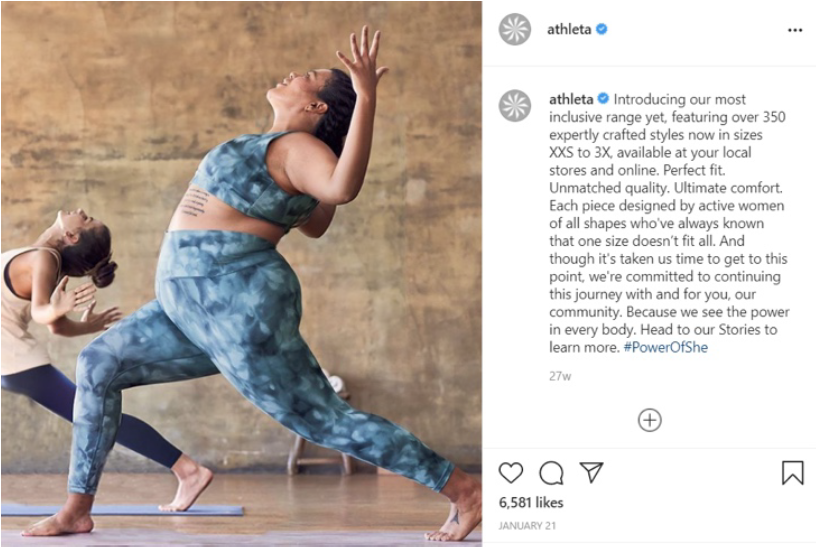 Athleta posts about size inclusivity on social media on January 21, 2021
Athleta posts about size inclusivity on social media on January 21, 2021Source: Athleta/Instagram[/caption]
Campaigns To Broaden Inclusivity
Retailers are launching multi-platform campaigns and merchandising initiatives to underscore their commitment to inclusivity across brands and products, helping to make inclusivity more mainstream and to create messaging that resonates with a wider consumer base.
Below, we highlight how two retailers are approaching inclusivity campaigns on social media in two different ways.
- Sephora has integrated diversity into its corporate strategy—across hiring, products, suppliers and social media. The retailer has pledged to double the number of Black-owned brands on its shelves by the end of 2021, and its fall cross-platform marketing campaign (in-store, via its online site and on social media) features Black-owned brands across all of its product categories. The consistent messaging and features from its website are communicated across all of Sephora’s social platforms—for example, the company promotes its Black-owned (and other) brands via its Instagram feed. Sephora has increased the proportion of Black-owned brands featured in its quarterly digital social media campaigns from 11% in June 2020 to 15% in July 2021, according to the company.
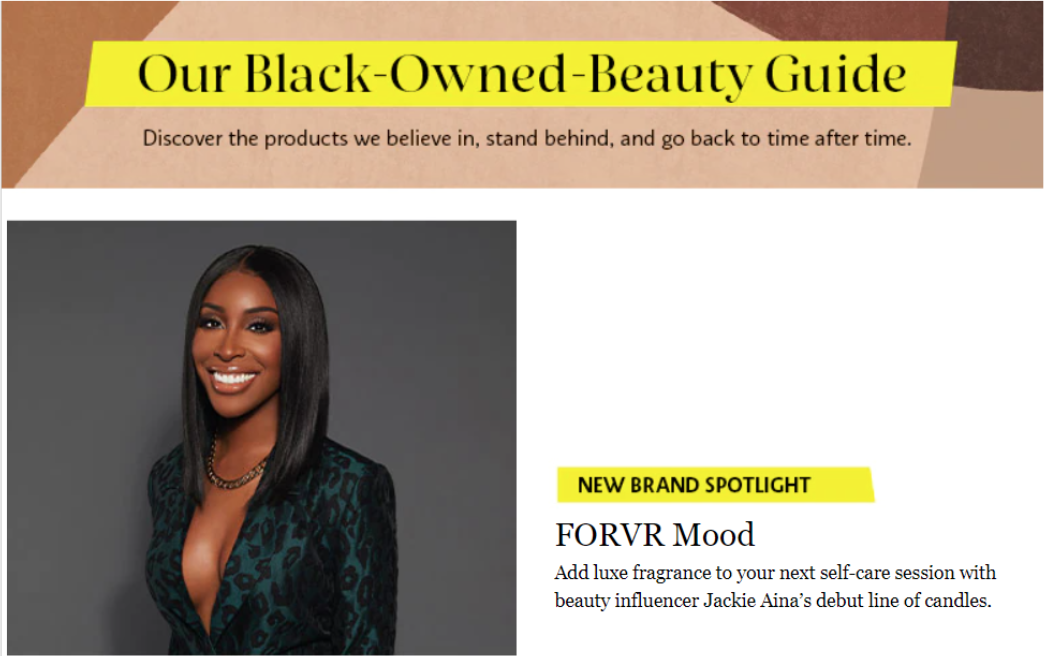 Sephora Black-owned brands: FORVR brand spotlight
Sephora Black-owned brands: FORVR brand spotlightSource: Sephora[/caption]
- Department store chain JCPenney recently relaunched its diversity and inclusivity strategy, which includes social media campaigns.
- The company announced its plans for JCPenney Beauty on July 20, 2021, which it described as an inclusive in-store and online experience that “reflects customers’ beauty wants and needs, no matter their age, gender, race, skin tone, hair type, beauty regime or budget.” The company announced that it would create a shop-in-shop experience in partnership with Thirteen Lune, a beauty and wellness e-commerce platform designed to inspire the discovery of Black- and Brown-owned and other inclusive beauty brands. Thirteen Lune promotes its inclusivity focus on social media; it has 13,000 followers on Instagram.
- The company launched “Thereabouts” on July 15, 2021, a private-label kids brand for the back-to-school season, which includes extended sizing and adaptive features including tagless and seamless features. JCPenney’s campaign emphasizes that the brand serves the needs of all children—an important marketing and merchandising distinction, as many adaptive apparel brands and extended-size brand launches are treated as separate to standard offerings. (Read Coresight Research’s Think Tank on the US adaptive apparel market for more on this topic.)
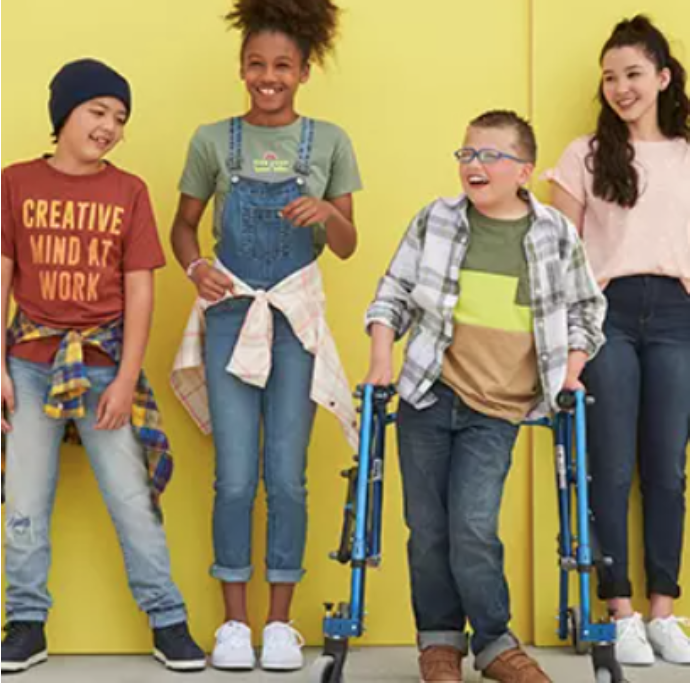 JCPenney’s Thereabouts is an inclusive private-label brand
JCPenney’s Thereabouts is an inclusive private-label brandSource: JCPenney[/caption]
Digital Merchandise Identifiers
Retailers and brands are helping consumers find BIPOC (Black, Indigenous and People of Color)-owned brands on digital platforms by adding product identifiers, such as logos or seals, to merchandise. Digital merchandise identifiers enable brands to support diversity and inclusivity—and be seen to do so through social media and other online channels.
- Target has a seal that identifies products from Black-owned brands (51% owned, controlled, or operated by Black persons). Among the company’s diversity, equity and inclusive initiatives, Target pledged in April 2021 that it will spend $2 billion on Black-owned suppliers by 2025 and plans to add products to its shelves from more than 500 Black-owned companies.
 Target’s Black-owned brand seal
Target’s Black-owned brand sealSource: Target[/caption]
What We Think
While social media and marketing represent the final stages of presenting a brand to the consumer, it is not the first time that a brand or retailer should be thinking about inclusivity: Diversity and inclusion should be embedded into organizations through diverse teams and leadership, into product designs, and into the supply chain through diverse product owners and suppliers. Communicating these initiatives to consumers via social media is a way for brands and retailers to promote their values and engage with a broad consumer base.
Brands and retailers have an opportunity to better represent the diverse US population through their advertising campaigns, as well as through their brand and product portfolios. Consumers want to see people that look like them represented by brands; it helps them to establish a connection with a brand and increases the likelihood that they would become a customer.
Brands and retailers can work with influencers and brand ambassadors on social media to be more inclusive and help create online communities that provide valuable feedback on products and messaging. Influencers are valuable to brands in connecting with consumers through their own channels, as they have their own following and authenticity, which cannot be replicated by a brand campaign. Brand ambassadors are effective to provide inspiration for consumers, as many brand ambassadors are celebrities, professional athletes, models and activists. Many beauty, luxury and sports brands have had much success using global brand ambassadors, building their brands appeal internationally.
Although it is important for brands and retailers to highlight inclusivity and diversity via online channels in the short term as they strive to provide representation for brands on the shelf and consumers in advertising and products, we expect that social media campaigns will be increasingly all-encompassing rather than calling out the “inclusive” elements—reinforcing true inclusivity.